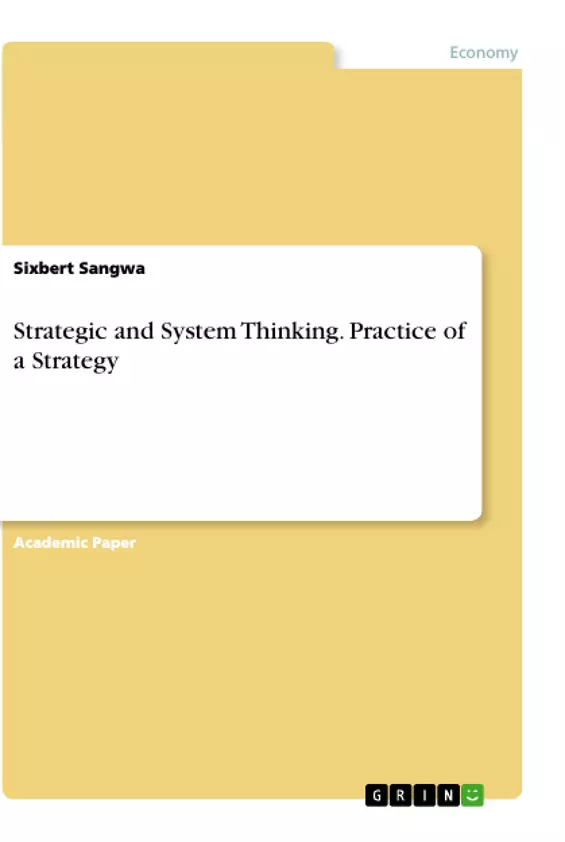This essay serves as a critical appraise of the statement: "Systems thinking essentially seeks to understand phenomena as a whole formed by the interaction of parts" in relation to changing ideas of strategic thinking. It explains how this statement exists within the author’s business approach to strategic management. The key themes addressed consist of an analysis of approaches to strategic thinking, systems thinking, complexity perspective - especially the new ways of thinking about strategy, - complex adaptive systems - especially 'Modelling Complexity', and 'The Practice Perspective'.
Today’s business environment is complex, dynamic, multi-faceted and the environment has a far- reaching impact. As for other organizations, the author’s company’s environment is a combination of several factors that surround and affect it. Therefore, the management of such environment requires managers to carry out a careful analysis of the entire environment to have a clear understanding on how to position the firm in the industry based on fitting the strategy to the current business environment.
The implication is that business managers should scan both the internal and external environment to adopt /develop strategies that they think will make their businesses successful. One of the biggest breakthroughs in how we understand and guide change in our organizations is systems theory and systems thinking. System thinking and strategic thinking are two interrelated terms that deal with examining patterns and lead to decision-making and the planning for execution at the organizational level.
To understand how both strategic and system thinking are used in organizations, it will be clearly defined what systems are. To be able to evaluate strategic system thinking and systems tools in an organization, both strategies and systems need to be explicitly defined. This will also lead to an analysis of the complexity of organizational system.
Inhaltsverzeichnis (Table of Contents)
- Introduction
- Strategy
- Intended/deliberate and emergent strategy
- Strategic thinking
- System thinking
- Simple and complex systems
- Practice of a strategy
- Understanding how managers differ in strategizing
- Understanding environment in strategic management
- Strategic tools for analyzing business Environment
- Strategic Change Management
- Strategic Risk Management
Zielsetzung und Themenschwerpunkte (Objectives and Key Themes)
This essay provides a critical evaluation of Stacey's statement regarding systems thinking and its relationship to changing ideas of strategic thinking. The essay aims to explain how systems thinking exists within the author's business approach to strategic management.
- Approaches to Strategic Thinking
- Systems Thinking and its application to strategy
- Complexity Perspective and New Ways of Thinking about Strategy
- Complex Adaptive Systems, particularly the modeling of complexity
- The Practice Perspective of Strategic Management
Zusammenfassung der Kapitel (Chapter Summaries)
- Introduction: This chapter sets the context by emphasizing the complexity of today's business environment and the need for effective strategic management. It introduces the concept of systems thinking and its relevance to organizational change and decision-making. The chapter then provides definitions of strategy and its various forms, including intended/deliberate and emergent strategies.
- Strategic Thinking: This chapter explores the nature of strategic thinking as a process of considering long-term vision, planning for implementation, and adapting to changing realities. It emphasizes the importance of foresight, planning, and decision-making in achieving long-term goals.
- System Thinking: This chapter defines systems thinking as a way of understanding the relationships between different parts of a system and their impact on the whole. It highlights the role of systems thinking in strategic management, specifically in performance management and organizational change.
- Simple and Complex Systems: This chapter distinguishes between simple and complex systems based on their number of components. It clarifies that the complexity of a system is not necessarily related to its difficulty.
- Practice of a Strategy: This chapter examines different aspects of strategic management, focusing on how managers approach strategic decision-making, how they analyze their environment, and how they utilize strategic tools. It also discusses topics like strategic change management and strategic risk management.
Schlüsselwörter (Keywords)
The primary focus of this work revolves around the intersection of strategic thinking and systems thinking. Key terms and concepts include strategic systems thinking, strategic tools, linear thinking, systems thinking, strategy, synergy, complexity, and complex adaptive systems.
- Quote paper
- Dr. Sixbert Sangwa (Author), 2017, Strategic and System Thinking. Practice of a Strategy, Munich, GRIN Verlag, https://www.grin.com/document/1014892



